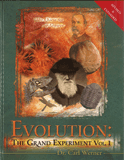
Did Mammals Evolve to Rule the Night?
News to Know
Abstract
Evolutionary researchers contend mammalian ancestors evolved night vision before the age of dinosaurs.
News Source
Eyes suited for night vision evolved in mammalian ancestors 100 million years before mammals themselves evolved, according to a study published in Proceedings of the Royal Society B. The study focuses on bony rings in the eyes of synapsids, animals widely thought by evolutionists to be the common ancestors of reptiles and mammals. The bony rings limit the amount of light that can enter the eye, and rings with larger openings are thought to correlate with better night vision.
Ringing in the Night
Long before the first mammals—320 million years ago, they say—some synapsids evolved sufficiently large bony rings to thrive in the night, according to Chicago Field Museum of Natural History paleontologist Kenneth Angielczyk, lead author of the study. This would have been, the authors contend, a helpful trait to pass on to the earliest mammals, which presumably would need to evade predators in the dark for millions of years until mammals could rise to dominate the earth. (Living mammals, nocturnal or not, do not have the bony rings but optimize their night vision with other anatomical designs. Roughly half the species of living non-marine mammals are nocturnal and many others are active in the night.1)

Bony scleral rings in birds and reptiles surround the iris and limit the size of the opening that admits light to the eye. Larger rings are thought to correlate with greater nocturnal adaptations. On the left are skulls from a Nile monitor lizard (a) and a gecko (b) with the scleral ring (SR) labeled. On the right are two of the 24 species of extinct synapsids researchers discovered with scleral rings. Image: K. Angielczyk and L. Schmitz, “Nocturnality in synapsids predates the origin of mammals by over 100 million years,” Proceedings of the Royal Society B 281 (2014): 20141642.
Finding Rings to Rule The Night
The bony rings are called scleral rings or scleral ossicles. They surround the iris of the eye and therefore limit the size of the opening through which light can be admitted. An eye able to dilate to a very large size can admit more light and therefore see better at night than an eye limited by a smaller ring. Found in birds and some reptiles2 and dinosaurs3 but not mammals, the bony rings are small and not consistently preserved in fossils. The researchers in this study searched museums worldwide to see whether purported mammalian ancestors possessed these bony rings and what might be learned from them.
“Specimens with well-preserved scleral rings are rare, so it took a lot of searching,” Angielczyk says. The researchers found 24 fossilized species of synapsids with preserved scleral ossicles. The fossils came from many places in the fossil record, ranging from Carboniferous to Jurassic rock layers. From these they calculated the light-gathering ability that the owners of the little bones probably had. They determined that synapsids with scleral ossicles varied greatly in their ability to see at night. Some were well adapted to the dark and others to the daytime. Those they thought were predators and those they believe to be more ancient were the ones that turned out to be calculated as nocturnal. Therefore the authors believe the nocturnal adaptation evolved early in the history of mammalian ancestors.
“The study does give us new insights into the daily lives of some of our most ancient relatives,” Angielczyk says. Their findings contradict previous views that held mammalian nocturnality didn’t evolve until mammals themselves evolved it to be able to evade dinosaurs. The discovery of nocturnal-type scleral ossicles in animals believed to be mammalian ancestors shows, the authors believe, that primordial mammals entered the world of dinosaurs already equipped for night life.
Buried Biodiversity Not Biological Evolution
Mammals do not have scleral ossicles because they were not designed with them. These extinct non-mammalian animals had scleral rings because they were designed with them, not because they evolved them. Based on what is known from the vision and behavior of living animals, it is reasonable to associate their varied ring and eye sizes with varying light sensitivity that make some animals better equipped to haunt the night than others. However, the findings reveal nothing about the evolution of mammals or of anything else. The distribution of varying scleral ring sizes among synapsids in the fossils record does not tell anything about the time by which animals of any kind evolved the ability to face daytime dangers. Why? Because they were all buried catastrophically over the course of just a few days or weeks during the global Flood.
The order of burial in the fossil layers is primarily a record of the order in which animals were buried during the global Flood about 4,350 years ago and in no case represents the time at which anything evolved. While the size of scleral rings is a helpful way to make educated guesses about the visual capabilities of extinct animals, what this study demonstrated is the various visual adaptations that existed among these extinct animals. These were all buried catastrophically and suddenly by waterborne sediment during the global Flood, preserving in some these small bones. And while scleral ring size may tell us something about the wide ranging capacity of these non-mammalian animals to navigate better in either the day or the night, these bones tell us nothing at all about the evolutionary history or the vision of mammals.
God created all kinds of animals about 6,000 years ago and designed them, as we see in Genesis 1, to reproduce only within their created kinds. Biological observations do not reveal any way animals can evolve into new more complex kinds of animals, and the presumption that they did so is a worldview-based assumption. To assume that mammals evolved from synapsids or anything else is a worldview based assumption, not a scientific fact. It is a pity that so many animals are extinct and that their characteristics can only be guessed at from the fossil record, but the fossil record does not reveal when or how they came to exist.
Further Reading
- www.truthinscience.org.uk: Synapsids and the Evolution of Mammals
- Dinos in the Dark
- Review: Your Inner Reptile
For More Information: Get Answers
Remember, if you see a news story that might merit some attention, let us know about it! (Note: if the story originates from the Associated Press, FOX News, MSNBC, the New York Times, or another major national media outlet, we will most likely have already heard about it.) And thanks to all of our readers who have submitted great news tips to us. If you didn’t catch all the latest News to Know, why not take a look to see what you’ve missed?
(Please note that links will take you directly to the source. Answers in Genesis is not responsible for content on the websites to which we refer. For more information, please see our Privacy Policy.)
Footnotes
- “The majority of extant mammals are nocturnal (45–55% of non-marine species) and many of the remaining species, especially large-bodied ones, are cathemeral [active both day and night]. Diurnality [active only in the day] is present in a few mammalian clades such as primates, but is much less widespread. Because nocturnality is so pervasive among extant mammals, it has long been hypothesized to be the ancestral activity pattern for the clade.” From K. Angielczyk and L. Schmitz, “Nocturnality in synapsids predates the origin of mammals by over 100 million years,” Proceedings of the Royal Society B 281 (2014): 20141642, dx.doi.org/10.1098/rspb.2014.1642.
- “Extant crocodiles and snakes, for example, do not have scleral ossicles yet other reptiles such as lizards and chelonians [turtles, terrapins, and tortoises] have a distinct ossified scleral ring composed of 14 individual plates. Most birds have about 12-15 of these bony plates with their shape varying greatly amongst different families.” From T. A. Franz-Odendaal and B .K. Hall, 2004 “The development and distribution of scleral ossicles in vertebrates: who has them and how do they form,” SICB meeting abstract, http://www.sicb.org/meetings/2004/schedule/abstractdetails.php3?id=295.
- Bony fish also have scleral ossicles but they are not ring shaped. Scleral rings are found in many dinosaurs and flying reptiles. (See “Dinos in the Dark.”)
Recommended Resources

Answers in Genesis is an apologetics ministry, dedicated to helping Christians defend their faith and proclaim the good news of Jesus Christ.
- Customer Service 800.778.3390
- © 2024 Answers in Genesis



